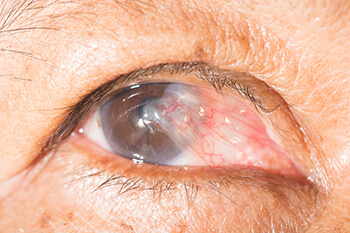Pterygium
 The conjunctiva is the skin that covers the white part of the eye. The cornea is the clear front window of the eye. Normally, the conjunctiva does not extend over the cornea.
The conjunctiva is the skin that covers the white part of the eye. The cornea is the clear front window of the eye. Normally, the conjunctiva does not extend over the cornea.
If the conjunctiva becomes fibrous and begins to grow onto the cornea, a pterygium has formed. These growths are very common, especially among people with a lot of exposure to sunlight and dust.
Typically, a pterygium will grow and change very slowly over many years.
There are several reasons to consider the removal of a pterygium:
- It is causing problems with vision
- It is causing irritation, redness, or pain
- It is cosmetically bothersome
The removal of a pterygium is a surgical procedure. The main risk of this procedure is that the pterygium could recur. The risk of recurrence is reduced by using one of two materials to cover the area that the pterygium is removed from.
- The patient’s own conjunctiva can be used to cover the area. This conjunctiva is taken from a different region of the same eye and then moved into position.
- An amniotic membrane graft can be used to cover the area. This tissue is donated by women undergoing a cesarean section. It is processed and extensively tested to ensure that it is free of any infection. Using amniotic membrane grafts in eye surgery is safe, effective, and widespread.
Visit the American Academy of Ophthalmology’s EyeSmart® website to learn more about Pterygium.



